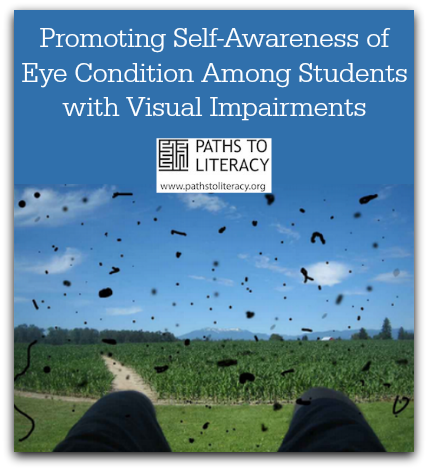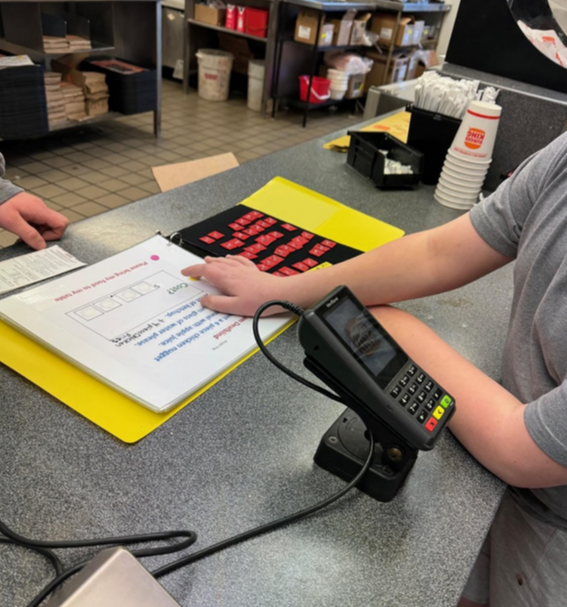Here is a lesson plan I use when teaching students about their eye conditions. I find it VITAL that the students learn about their conditions so they can better assist those working with them on their needs. This includes both educational and medical professionals. This is also an excellent way to address the area of Self-Determination from the Expanded Core Curriculum (ECC).
I’ve had the students do research at home with their families writing me a report based on their findings. We’ve done “field trips” to the eye doctor… typically scheduled appointments that I follow along to and the student asks the eye care professional about their vision or the glasses and why they do what they do prior to ordering them (the fitting process).
Learning objective
(Performance, conditions, and criterion): The student will learn about their eye condition and be able to verbalize about their eye condition appropriately to others in different school and social environments moving from role playing scenarios to real life situations with 90% independence and accuracy.
Common Core or State Standard(s):
- Component 3.1: Uses knowledge of topic/theme, audience, and purpose to plan presentations.
- Component 3.3.1: Applies skills and strategies for the delivery of effective oral communication and presentations.
- Writing
- EALR 2: The student writes in a variety of forms for different audiences and purposes.
- EALR 3: The student writes clearly and effectively.
- Health and Fitness
- Recognizes the structure and function of the body systems (circulatory, respiratory, skeletal, muscular, digestive, and nervous)
Materials
- I need:
- Eye report
- Model of the eye
- Student need(s):
- Braille or large print copy of the report
Procedure
- Context for learning
- 1:1 setting in instructional phase moving to classroom settings to practice skill set
- Pre-lesson assessment date and data:
- Pretest date: 11-7-2011; based on the teacher created pre/post test, student was unable to state anything about her eye condition, acuities, or visual needs
- IEP link to goals & objectives
- **Lesson was started prior to including it into the IEP; based on parental consent and wishes, instruction was started based on her current objective:
- “Kimberly will advocate for herself by requesting curricula materials be given to her in Braille in each of her classes 8 out of 10 times in all her subject area classes.”
- Pre-instructional Set
- An eye model was used to demonstrate how the human eye works.
a) Gain student’s attention: Internet research https://www.vincyp.scot.nhs.uk/conditions/
b) Inform students of learning objective(s): remind student of her desire to learn more about her visual condition.
c) Use informed instruction: This is important to know because “you are the only person who knows yourself and what you need the best. You will be able to talk to the teachers, your classmates, eye doctor faster than your vision teacher, O&M, or your parents can. Once you are in the work force, you will be able to tell your boss what you can do and what you might need help or additional training for.”
- Prepare students for Instructional Content: remind student that as a result of their desire to learn about their visual condition, they will be learning how the eye works, what accommodations/modifications would work best for them, what their acuities are, reviewing their eye report, etc.
Plan I
a) Review of prerequisite skills (if applicable).
b) Activate prior knowledge (if applicable): Discuss what occurs at her eye doctor appointments.
c) Pre-teach key vocabulary: acuity, peripheral fields, photophobia, intraocular pressure, legal blindness, functional blindness, Lebers Congenital Amaurosis, and Senor Loken Syndrome
- Assessment
- How will you know whether students have met your learning objective? When she has demonstrated independence in at least 7 of the 10 skill areas in the teacher made pre/post test
- Assessment activities must be concrete and tangible – not only will the pre/post test be given, but student will also create a booklet about herself to be given to prospective students (the booklet was the student’s idea as she was asked to explain how to determine when she had mastered the goal)
- Closure
- Student to present her findings at her annual IEP/evaluation meeting and determine her next IEP objectives in the ECC
Active review:
Organize/transition: Students put their work in their folder and return to storage spot and transition to next lesson/activity.
Homework or follow-up activity:
Homework for the summer is to practice reviewing her booklet about herself, as she will be leading the meeting with her teachers in the fall about her vision and her strengths/needs.
- Notes for Accommodations and Paraprofessional Support
- See accommodations list student created
- The student created a list of tasks that the paraprofessional currently does for her and expressed an interest to no longer have a 1:1. The student and the paraprofessional will be working together to fade the para out of the classroom when the student indicates the desire to be independent in the classroom/activity
Paraprofessional support: Para will need training on how to fade back on services and how to assist student in determining how/when to have para leave them.
Resources
- National Agenda for the Education of Children and Youths with Visual Impairments, Including Those with Multiple Disabilities: A Teacher Perspective
- Bishop, Virginia. (1986) Selected Anomalies and Diseases of the Eye.
- Wolffe, Karen. (2005) Transition Competencies Checklist.






